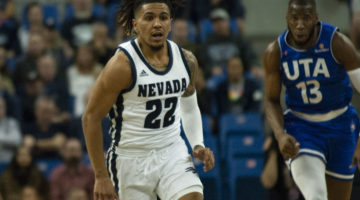The Democratic National Committee recently announced that the first Democratic primary debate will be held in Nevada on Oct. 13. This announcement may lead some to question: Why Nevada?
The fact is that regardless of its relatively low population and vast amount of federally owned land, Nevada is a politically important state. It is the third state in the primary process, electing the presidential candidates to move on to the general election after Iowa and New Hampshire. This position as an early voting state means that the outcomes of the caucuses are instrumental in projecting which candidates will eventually win their party’s nomination.
In addition, the population distribution of the state is such that those of us in Washoe County can be assured that our vote does indeed matter.
The millennial generation is one of the largest potential voting blocs in the country, yet it is also one that has been largely overcome with political apathy and mistrust in recent years. According to an article published in the Harvard Political Review, millennials’ participation in politics has been on a sharp decline since the 2008 presidential elections, and a 2015 poll by the Harvard Institute of Politics found that 49 percent of millennials have little to no faith in the fairness of the judicial system.
Despite our generation’s tendency to remove ourselves from the political process we may not even trust, those of us in Washoe County are in a unique position. We’re in a position where our really vote matters, and here’s why.
WE’RE ALL SWINGERS HERE
Nevada is a swing state, and Washoe County is a swing county. This means that the presidential candidates that win Nevada have to win Washoe County in addition to Clark County. Sorry, White Pine, Elko and friends, but you don’t matter all that much.
Washoe is one of the state’s two population centers and as such has the power to sway the election outcome of the entire state. In both the 2008 and 2012 presidential elections, Barack Obama won Nevada; Washoe and Clark were the only two counties in the state to go blue, and that’s all it took to gain Nevada’s six electoral votes.
MINORITY PRIORITIES
According to a project titled The States of Change: Demographics and Democracy, a joint project by the Center for American Progress, the American Enterprise Institute and a demographer of the Brookings Institute, the demographics of Nevada are changing such that by 2019 it will become a “majority-minority” state — one in which racial and ethnic minority groups constitute more than 50 percent of the state’s population.
If you are an ethnic minority living in Nevada, this election is the opportune time to vote for the candidate that you feel best represents your interests. Before the term for the 45th president is up, your needs will be the needs of the majority in Nevada. But there’s no guarantee that those needs will be addressed unless you act to make your voice heard by those who are responsible for shaping the nation’s public policy.
Whether you care about raising the minimum wage, enacting criminal justice or immigration reform, or ensuring you have access to health care, your participation in the political process goes a long way in making these changes happen.
NOT CHOOSING A SIDE MEANS CHOOSING THE SIDE OF THE OPPRESSOR
This goes out to those of you who thought it was a good idea to be conscientious objectors of the two-party system. The Washoe County Registrar of Voters reports that there are 42,206 nonpartisan voters in Washoe County. That’s 42,206 people who can’t caucus for the candidate of their choice.
Nevada has a closed caucus, which means that if you want to support a Democratic candidate you have to be a registered Democrat; if you want to support a Republican, you have to be a registered Republican. And pro tip: If you’re one of the 10,915 people who registered with the Independent American Party, you’re not actually “independent” — you’re affiliated with an ultra-conservative political party that doesn’t have any candidates in the 2016 race. If that’s where you want your allegiance, that’s fine, but you still can’t caucus unless you re-register.
Fortunately, you can change your party affiliation up to and on the day of the caucus.
SO HOW DO WE DO THE THING?
With all this talk of “caucusing,” it’s time we address what the hell a caucus actually is.
If you played the game red rover as a child, you’re halfway to understanding the caucus on the precinct level. Unlike a primary election in which you fill out your ballot and leave, a caucus counts your physical presence as your vote. The Nevada caucuses will be held on Feb. 20 for Democrats and Feb. 23 for Republicans. On these dates, participants gather at a public venue determined by their residential precinct, and are separated into groups according to whom they support.
A head count is done, and the candidates who don’t have enough supporters to be “viable” (according to caucus math) are eliminated. Participants who supported those candidates are then essentially up for grabs; the teams representing the viable candidates have an allotted amount of time to convince as many nonaligned caucusers as they can to join their group, adding more support for their candidate.
CONFUSED YET?
Don’t worry. There are plenty of resources available to help you understand the process. For a more detailed explanation, head to nevadacaucus.com. If you want to participate in a real-life caucus practice, the Associated Students of the University of Nevada are hosting a mock caucus (or “mockus”) on Monday, Oct. 26, from 11 a.m. to 2 p.m.
The Nevada Sagebrush editorial desk can be reached at tbynum@sagebrush.unr.edu and on Twitter.













